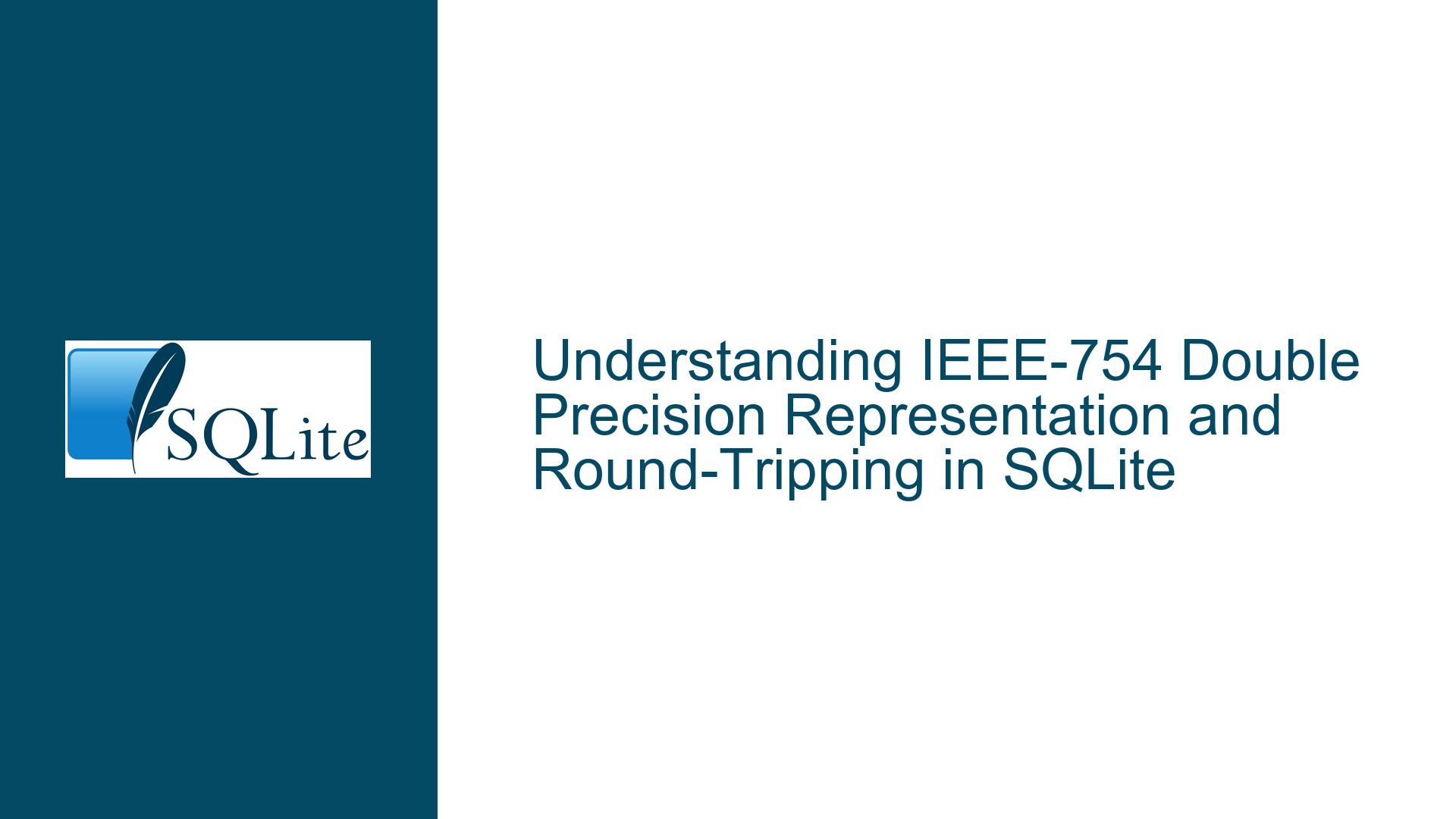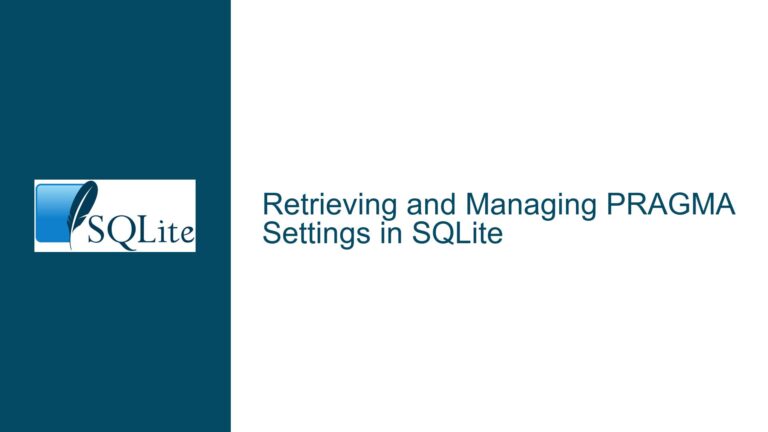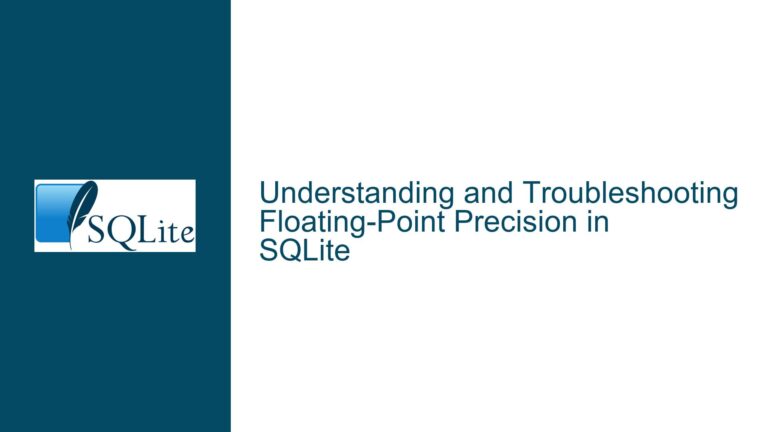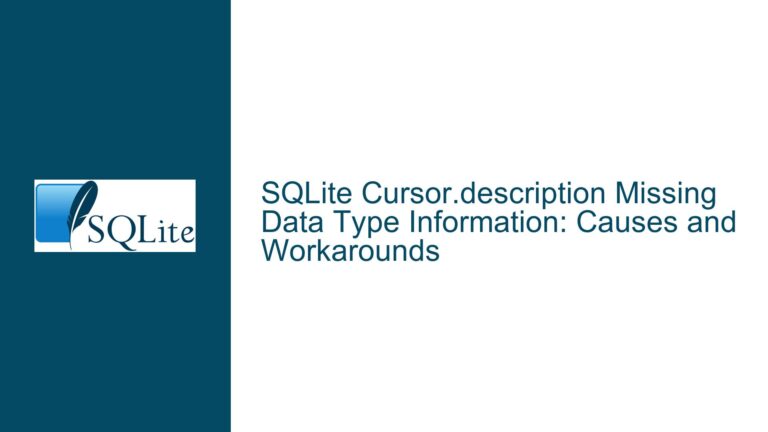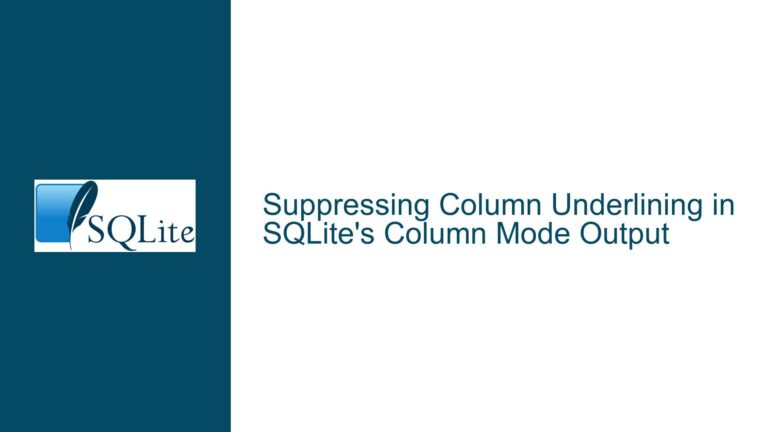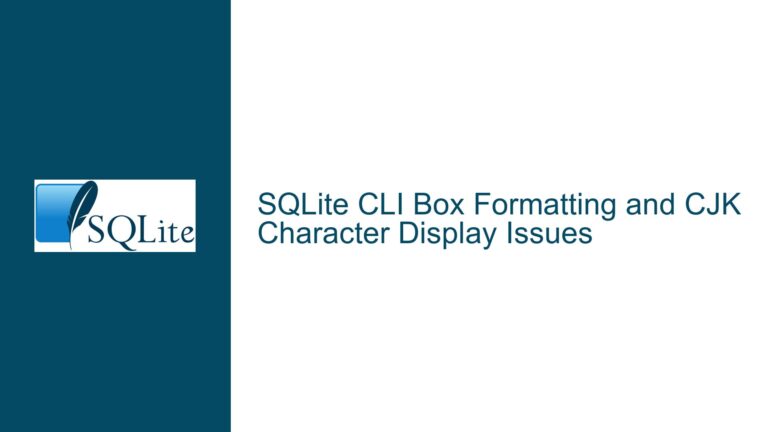IEEE-754 Double Precision Representation and Round-Tripping in SQLite
IEEE-754 Double Precision Representation and Decimal Conversion
The core issue revolves around the representation of IEEE-754 double-precision floating-point numbers in decimal form and the ability to accurately round-trip these values between their binary and decimal representations. The discussion highlights the nuances of how SQLite handles floating-point numbers, particularly when converting them to and from text representations. The primary contention is whether a 17-digit decimal representation is sufficient to accurately represent any IEEE-754 double-precision floating-point number, ensuring that the conversion back to the original binary form is lossless.
The IEEE-754 standard defines the binary representation of floating-point numbers, which includes a sign bit, an exponent, and a mantissa (also known as the significand). The double-precision format (binary64) uses 64 bits: 1 bit for the sign, 11 bits for the exponent, and 52 bits for the mantissa. This format allows for a wide range of values with a precision of approximately 15.95 decimal digits. However, the challenge arises when converting these binary values to decimal form, as not all binary64 values can be represented exactly with a finite number of decimal digits.
The Distinction Between Round-Tripping and Exact Decimal Representation
The discussion reveals a critical distinction between two concepts: round-tripping and exact decimal representation. Round-tripping refers to the ability to convert a binary64 value to a decimal string and then back to the original binary64 value without any loss of information. This process requires that the decimal representation be precise enough to uniquely identify the original binary64 value. On the other hand, exact decimal representation refers to the ability to express the binary64 value as a decimal number that is mathematically equal to the original binary value. This distinction is crucial because while a 17-digit decimal representation may be sufficient for round-tripping, it may not be sufficient for exact decimal representation.
The IEEE-754 standard guarantees that every binary64 value can be mapped to a unique 17-digit decimal number that allows for accurate round-tripping. This means that if you convert a binary64 value to a 17-digit decimal string and then back to binary64, you will recover the original value. However, this does not imply that the 17-digit decimal string is an exact representation of the binary64 value. In fact, many binary64 values require more than 17 decimal digits to be represented exactly. For example, the smallest positive binary64 value, which is approximately 4.94065645841247e-324, has an exact decimal representation that requires 757 digits. This discrepancy arises because the binary64 format can represent numbers with much higher precision than what can be expressed with a limited number of decimal digits.
The Role of the %!.17g Format Specifier in SQLite
The discussion also delves into the specifics of how SQLite handles floating-point conversions using the %!.17g format specifier. The %!.17g format specifier is a variation of the %.17g format specifier, which is used to format floating-point numbers with up to 17 significant digits. The exclamation mark (!) in the format specifier is a SQLite-specific extension that ensures the output is formatted in a way that allows for accurate round-tripping. Without the ! specifier, the formatted output may not be sufficient to guarantee accurate round-tripping, especially for values that require more than 16 significant digits.
The %!.17g format specifier is particularly important in SQLite because it ensures that the decimal representation of a binary64 value is precise enough to allow for accurate round-tripping. This is crucial for maintaining data integrity when storing and retrieving floating-point values in a database. For example, if you store a floating-point value in a SQLite database and then retrieve it later, you want to be sure that the retrieved value is exactly the same as the original value. The %!.17g format specifier helps achieve this by providing a decimal representation that is precise enough to uniquely identify the original binary64 value.
The Impact of Compiler and Platform Differences
Another important aspect of the discussion is the impact of compiler and platform differences on floating-point representation and conversion. The behavior of floating-point arithmetic can vary depending on the compiler and platform being used. For example, the Microsoft C runtime and the GNU Compiler Collection (GCC) may handle floating-point conversions differently, leading to discrepancies in the results. This is particularly evident when dealing with very small or very large floating-point values, where the precision of the floating-point arithmetic can have a significant impact on the results.
In the discussion, it is noted that the Microsoft C runtime may not handle floating-point conversions as accurately as GCC, especially when dealing with values that require more than 16 significant digits. This can lead to situations where the same floating-point value is represented differently on different platforms, even when using the same format specifier. This highlights the importance of understanding the limitations of the compiler and platform being used, especially when working with floating-point arithmetic in a database context.
The Importance of Guard Bits and Rounding Modes
The discussion also touches on the importance of guard bits and rounding modes in floating-point arithmetic. Guard bits are additional bits used in intermediate calculations to ensure that the final result is accurate to the desired precision. The IEEE-754 standard requires that floating-point operations be performed with sufficient guard bits to ensure that the result is accurate to within half a unit in the last place (ULP). This means that the result of a floating-point operation should be as close as possible to the mathematically exact result, with any rounding errors minimized.
The rounding mode used in floating-point arithmetic can also have a significant impact on the results. The IEEE-754 standard defines several rounding modes, including round-to-nearest, round-toward-zero, round-toward-positive-infinity, and round-toward-negative-infinity. The round-to-nearest mode is the most commonly used and is the default in most implementations. This mode rounds the result to the nearest representable value, with ties (i.e., values exactly halfway between two representable values) rounded to the nearest even value. This helps to minimize rounding errors and ensures that the results are as accurate as possible.
In the context of SQLite, the use of guard bits and the appropriate rounding mode is crucial for ensuring that floating-point conversions are accurate and consistent. This is particularly important when dealing with values that require more than 16 significant digits, as any rounding errors can lead to discrepancies in the results. The %!.17g format specifier helps to mitigate these issues by ensuring that the decimal representation is precise enough to allow for accurate round-tripping, even in the presence of rounding errors.
Practical Implications for SQLite Users
For SQLite users, the discussion has several practical implications. First, it is important to understand the limitations of floating-point arithmetic and the impact of compiler and platform differences on the results. When working with floating-point values in SQLite, it is crucial to use the %!.17g format specifier to ensure that the decimal representation is precise enough to allow for accurate round-tripping. This is particularly important when storing and retrieving floating-point values in a database, as any discrepancies in the results can lead to data integrity issues.
Second, it is important to be aware of the distinction between round-tripping and exact decimal representation. While a 17-digit decimal representation may be sufficient for round-tripping, it may not be sufficient for exact decimal representation. This means that when working with floating-point values in SQLite, it is important to consider the precision requirements of your application and to use the appropriate format specifier to ensure that the results are accurate and consistent.
Finally, it is important to understand the role of guard bits and rounding modes in floating-point arithmetic. When performing floating-point operations in SQLite, it is crucial to ensure that the results are accurate to the desired precision, with any rounding errors minimized. This can be achieved by using the appropriate rounding mode and ensuring that sufficient guard bits are used in intermediate calculations.
Conclusion
In conclusion, the discussion highlights the complexities of representing IEEE-754 double-precision floating-point numbers in decimal form and the challenges of ensuring accurate round-tripping in SQLite. The %!.17g format specifier plays a crucial role in ensuring that the decimal representation is precise enough to allow for accurate round-tripping, even in the presence of compiler and platform differences. However, it is important to understand the distinction between round-tripping and exact decimal representation, as well as the impact of guard bits and rounding modes on the results. By understanding these concepts and using the appropriate format specifier, SQLite users can ensure that their floating-point calculations are accurate and consistent, even when dealing with very small or very large values.
